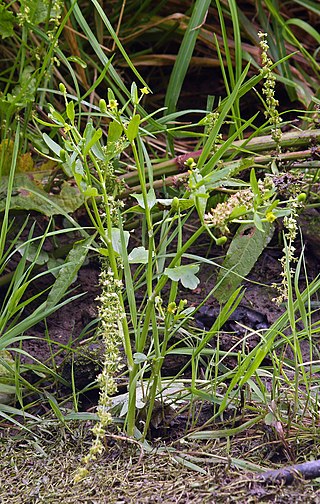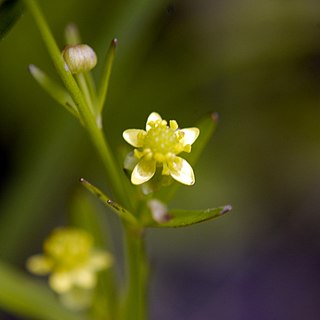
Ranunculus is a large genus of about 1700 to more than 1800 species of flowering plants in the family Ranunculaceae. Members of the genus are known as buttercups, spearworts and water crowfoots.

Ranunculus repens, the creeping buttercup, is a flowering plant in the buttercup family Ranunculaceae, native to Europe, Asia and northwestern Africa. It is also called creeping crowfoot and sitfast.

Ranunculus bulbosus, commonly known as bulbous buttercup or St. Anthony's turnip, is a perennial flowering plant in the buttercup family Ranunculaceae. It has bright yellow flowers, and deeply divided, three-lobed long-petioled basal leaves.

Ranunculus acris is a species of flowering plant in the family Ranunculaceae, and is one of the more common buttercups across Europe and temperate Eurasia. Common names include meadow buttercup, tall buttercup, common buttercup and giant buttercup.

Ranunculus glaberrimus, the sagebrush buttercup, is a species of flowering plant in the buttercup family, Ranunculaceae. It is native to interior western North America, in western Canada, the western United States, and the northwestern Great Plains.

Ranunculus sceleratus known by the common names celery-leaved buttercup, celery-leaf buttercup, and cursed buttercup is a species of flowering plant in the buttercup family Ranunculaceae. It has a circumpolar distribution in the northern hemisphere, native to temperate and boreal North America and Eurasia, where it grows in wet and moist habitats, including ponds and streambanks.
Ranunculus canus is a species of buttercup known by the common name Sacramento Valley buttercup. It is endemic to California, where it grows in the Central Valley and adjacent mountain foothills, and the Transverse Ranges just south. It grows in grassland and meadows in woodland and forest habitat. This plant can be very similar in appearance to the California buttercup, and may be difficult to distinguish from it. It is variable in form. In general the plant is a perennial herb producing erect, usually hairy stems up to 65 centimeters tall. The hairy leaves are each made up of three leaflets, leaves occurring lower on the plant with wider leaflets which may be notched to lobed, and upper leaves with narrow, toothed leaflets. The flower has up to 23 shiny yellow petals and many yellow stamens and pistils at the center. The fruit is an achene, borne in a spherical cluster of 11 or more.

Ranunculus eschscholtzii is a species of buttercup flower known by the common name Eschscholtz's buttercup.

Ranunculus flabellaris is a species of flowering plant in the buttercup genus, Ranunculus, known by the common name yellow water buttercup. It is native to much of North America, including the southern half of Canada and most of the United States.

Ranunculus hebecarpus is a species of buttercup known by the common name delicate buttercup. It is native to western North America, including several of the western United States and Baja California, where it grows in grassland, woodland, and chaparral habitat. It is an annual herb producing a slender, hairy stem a few centimeters high or up to 30 centimeters tall. The hairy leaves are borne on long petioles. Their blades are deeply lobed or divided into three leaflets, often with toothed or lobed edges. Flowers have 3 to 5 tiny yellow petals just 1 or 2 millimeters long studded on the bulbous nectary; some flowers lack petals. The plant is most easily identified in its fruiting stage, when the infructescence is a spherical cluster of several tiny disc-shaped achenes with compressed, bristly sides.

Ranunculus macounii is a species of buttercup known by the common name Macoun's buttercup. It is native to much of North America, from Alaska and northwestern Canada to Newfoundland and Labrador, and the contiguous United States except for the northeast and southeastern areas. It grows in many types of moist habitat, including marshes and wet areas woodlands and scrub. It is generally semi-aquatic, growing in or next to shallow water, or in muddy places. It is a perennial herb producing prostrate, spreading stems that root at nodes that come in contact with moist substrate, or growing erect and branching. The stems are generally hairy, but populations of hairless specimens are known. The leaves are mostly divided into three lobed, toothed leaflets which are borne on long, hairy petioles. The flowers each have five shiny yellow petals under a centimeter long around a center of many stamens and pistils. The fruit is an achene borne in a spherical cluster of 20 or more.

Ranunculus parviflorus is a species of buttercup known by the common name smallflower buttercup. It is native to Europe, but it is known on other areas of the world as an introduced species and sometimes a roadside weed, for example, in parts of Australia and the United States.

Ranunculus pusillus, commonly called low spearwort, is a species of flowering plant in the buttercup family (Ranunculaceae). It is native to much of the eastern United States from New York to Florida and west to Texas; it is also known in California. It grows in wet habitat, where it is semi-aquatic growing partially submerged or terrestrially on muddy substrates.

Ranunculus recurvatus, the blisterwort or hooked crowfoot, is a plant species of the genus Ranunculus in the family Ranunculaceae native to eastern North America. It is an early-flowering plant of moist deciduous woods from central Quebec south to Florida.
Ranunculus allenii, commonly known as Allen's buttercup, is a flowering plant in the crowfoot or buttercup family, Ranunculaceae. Generally found in wetlands in northern latitudes, it bears yellow flowers in summer, which are pollinated by insects.

Ranunculus abortivus is a species of flowering plant in the buttercup family, Ranunculaceae. Its common names include littleleaf buttercup, small-flower crowfoot, small-flowered buttercup, and kidneyleaf buttercup. It is widespread across much of North America, found in all ten Canadian provinces as well as Yukon and the Northwest Territories, and most of the United States, except Hawaii, Oregon, California, and parts of the Southwest.

Ranunculus cortusifolius, also known as the Azores buttercup or Canary buttercup, is a plant species in the genus Ranunculus, family Ranunculaceae, the buttercup or crowfoot family. It grows on moister sites throughout the Azores, Madeira and Canary Islands but is widely cultivated elsewhere as an ornamental. There are reports of it having become naturalized in parts of California.

Ranunculus acaulis, in Australia and New Zealand called dune buttercup, sand buttercup or shore buttercup, is a yellow-flowered, small, fleshy herb, that grows in mats in damp places mostly near the sea. It occurs naturally in Australia, New Zealand, Chile and the Falklands. It flowers between August and April and sets seed from September till July.

Ranunculus arcticus, the birdfoot buttercup, is a species of buttercup in the family Ranunculaceae. It has a circumpolar distribution in Northern Europe, Northern Asia and North America.

Ranunculus tripartitus, three-lobed crowfoot, is a species of flowering plant in the family Ranunculaceae, which grows in pools and muddy hollows in coastal parts of Europe, North Africa and West Asia. It is rare and endangered throughout its range, and is considered to be an indicator of favourable environmental conditions.



















